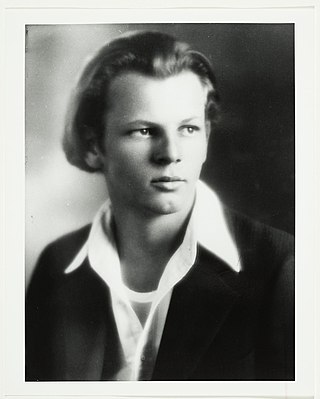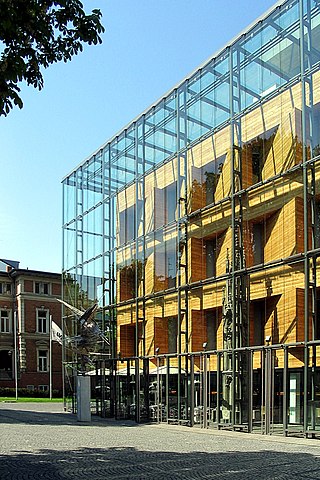
The Rheinisches Malermuseum is an art museum in Bonn, Germany. The museum is owned by a private association and has exhibits on forgotten artistic techniques and tools of the painter. It was established in 1985.

The Rheinisches Malermuseum is an art museum in Bonn, Germany. The museum is owned by a private association and has exhibits on forgotten artistic techniques and tools of the painter. It was established in 1985.
First plans for the foundation of such a museum existed already in 1979. With the foundation of a "Förderverein Rheinisches Malermuseum Bonn e.V." in 1985, more concrete plans for the design and financing could begin. Through membership in the Förderverein, retired master painters in particular were involved in the conception, construction and maintenance of the exhibition. The museum was opened on November 10, 1989.
The basis of the collection presented in the museum comes from the inheritance of a Bonn master painter. The detailed depiction of a painter's workshop around 1900, including the tools, paint mills, brushes, paints and other equipment in use at the time, forms the center of the small exhibition. Various techniques of the painter's craft are demonstrated by means of different designs for murals, ceilings and facade designs.
The history of the Bonn Guild of Painters and Decorators comprises another section of the exhibition. On the basis of flags, documents and invoices of the formerly independent guilds of Bonn, Bad Godesberg and the Rhein-Sieg district, the visitor gets an impression of the self-confidence of the painters' and decorators' trade in the Rhineland at that time. The original silver guild cup - a work from 1896 - is the showpiece of this exhibition area.
The museum is located at Berliner Platz 35-39, in the old painters' hall on the second floor of a former vocational school. Today, the separate building houses the gymnasium of the now closed Pestalozzi School, a former open all-day special school. Athletes from the Bonn Boxing Club train there. As an eye-catcher, the painted exterior façade from the Wilhelminian period is an advertisement for the museum that is visible from afar.

Hendrick Avercamp was a Dutch painter during the Dutch Golden Age of painting. He was one of the earliest landscape painters of the 17th-century Dutch school, he specialized in painting the Netherlands in winter. His paintings are colorful and lively, with carefully crafted images of the people in the landscape. His works give a vivid depiction of sport and leisure in the Netherlands in the beginning of the 17th century. Many of Avercamp's paintings feature people ice skating on frozen lakes.

Paul Jackson Pollock was an American painter and a major figure in the abstract expressionist movement. He was widely noticed for his "drip technique" of pouring or splashing liquid household paint onto a horizontal surface, enabling him to view and paint his canvases from all angles. It was called all-over painting and action painting, since he covered the entire canvas and used the force of his whole body to paint, often in a frenetic dancing style. This extreme form of abstraction divided the critics: some praised the immediacy of the creation, while others derided the random effects. In 2016, Pollock's painting titled Number 17A was reported to have fetched US$200 million in a private purchase.

Max Ernst was a German painter, sculptor, printmaker, graphic artist, and poet. A prolific artist, Ernst was a primary pioneer of the Dada movement and Surrealism in Europe. He had no formal artistic training, but his experimental attitude toward the making of art resulted in his invention of frottage—a technique that uses pencil rubbings of textured objects and relief surfaces to create images—and grattage, an analogous technique in which paint is scraped across canvas to reveal the imprints of the objects placed beneath. Ernst is noted for his unconventional drawing methods as well as for creating novels and pamphlets using the method of collages. He served as a soldier for four years during World War I, and this experience left him shocked, traumatised and critical of the modern world. During World War II he was designated an "undesirable foreigner" while living in France.

Oscar Edmund Berninghaus was an American artist and a founding member of the Taos Society of Artists. He is best known for his paintings of Native Americans, New Mexico and the American Southwest. His son, Charles Berninghaus (1905–1988), was also a Taos artist.

Quentin Matsys (1466–1530) was a Flemish painter in the Early Netherlandish tradition. He was born in Leuven. There is a tradition alleging that he was trained as an ironsmith before becoming a painter. Matsys was active in Antwerp for over 20 years, creating numerous works with religious roots and satirical tendencies. He is regarded as the founder of the Antwerp school of painting, which became the leading school of painting in Flanders in the 16th century. He introduced new techniques and motifs as well as moralising subjects without completely breaking with the tradition.

Frank Helmut Auerbach is a German-British painter. Born in Germany, he has been a naturalised British subject since 1947. He is considered one of the leading names in the School of London, with fellow artists Francis Bacon and Lucian Freud.
Morris Louis Bernstein, known professionally as Morris Louis, was an American painter. During the 1950s he became one of the earliest exponents of Color Field painting. While living in Washington, D.C., Louis, along with Kenneth Noland and other Washington painters, formed an art movement that is known today as the Washington Color School.

The Hague School is a group of artists who lived and worked in The Hague between 1860 and 1890. Their work was heavily influenced by the realist painters of the French Barbizon school. The painters of the Hague school generally made use of relatively somber colors, which is why the Hague School is sometimes called the Gray School.
The set decorator is the head of the set decoration department in the film and television industry, responsible for selecting, designing, fabricating, and sourcing the "set dressing" elements of each set in a Feature Film, Television, or New Media episode or commercial, in support of the story and characters of the script. The set decorator is responsible for each décor element inside the sets, from practical lighting, technology, art, furniture, drapery, floor coverings, books, collectables, to exterior furnishings such as satellite dishes, Old West water troughs, streetlamps, traffic lights, garden furniture and sculptures.
Helmut G. Tollmann born 1945 in Cologne, is a German artist, working now for about 50 years as a photographer, painter, performance and large screen multi-vision artist.

The Rheinisches Landesmuseum Bonn, or LVR-LandesMuseum Bonn, is a museum in Bonn, Germany, run by the Rhineland Landscape Association. It is one of the oldest museums in the country. In 2003 it completed an extensive renovation. The museum has a number of notable ancient busts and figures dating back to Roman times.

The Rheinische Landesmuseum Trier is an archaeological museum in Trier, Germany. The collection stretches from prehistory through the Roman period, the Middle Ages to the Baroque era with a strong emphasis on the Roman past of Augusta Treverorum, Germany's oldest city. Its collections of (local) Roman sculptures, Roman mosaics and frescos are among the best in Germany.

Alf Bayrle, also known as Alf Singer-Bayrle, was a German painter, printmaker and sculptor.

Godela Habel was a German painter and artist.

China painting, or porcelain painting, is the decoration of glazed porcelain objects such as plates, bowls, vases or statues. The body of the object may be hard-paste porcelain, developed in China in the 7th or 8th century, or soft-paste porcelain, developed in 18th-century Europe. The broader term ceramic painting includes painted decoration on lead-glazed earthenware such as creamware or tin-glazed pottery such as maiolica or faience.
Anselmo Govi was an Italian painter and decorator, a member of the late Art Nouveau school known in Italy as Liberty style.

Marie Danforth Page (1869–1940) was an American painter, mainly of portraits.
Achim Zeman in Stuttgart) is a German painter and installation artist. He is a representative of Op-Art and is based on the rules of Concrete Art.

The Ernst-Moritz-Arndt-Haus in the Bonn district of Südstadt was built for the poet Ernst Moritz Arndt.
Clemens Pasch was a German sculptor and painter.
Coordinates: 50°44′8″N7°5′38″E / 50.73556°N 7.09389°E